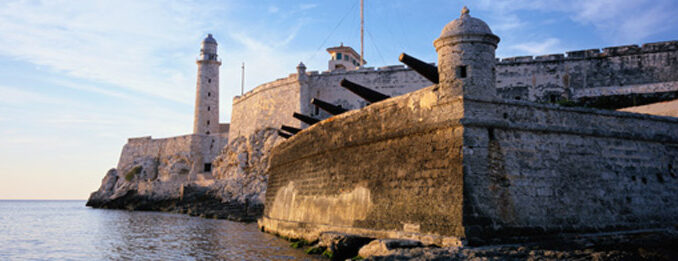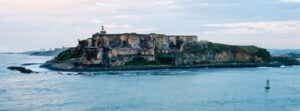

Don Tremain/Getty Images
El Morro Fortress, Havana, Cuba
Are you familiar with any forts in the United States? For example, have you heard of or visited Fort Sumter at Charleston Harbor, Fort Independence at Boston Harbor, or Fort MacArthur at Los Angeles Harbor? Spain, likewise, had forts built in Puerto Rico and Cuba to protect the major ports from sea invasions. One fort guards the port city of San Juan, Puerto Rico. In Cuba you’ll find two forts—one in Havana at the northwest end of the island, and the other in Santiago de Cuba at the southeast end. All three forts are referred to as El Morro. Why? Can you guess what El Morro means? It means promontory, or a piece of land jutting out into the water. These forts were built on promontories to better protect their cities. Learning about these Spanish forts makes the history of Spain in Cuba and Puerto Rico come alive! Today all three forts are UNESCO World Heritage sites.
El Morro in San Juan, Puerto Rico, also known as Castillo de San Felipe del Morro, guards San Juan Bay. In 1539, King Charles V of Spain authorized construction of the fortress in order to defend the port of San Juan. The fort was named to honor King Philip II. What began as a tower developed over the next 400 years into a huge six-level complex taking up the entire end of the peninsula. Throughout the years, El Morro survived many attacks, such as the one led by the Englishman Sir Francis Drake in 1595. The last attack at El Morro was made by the United States Navy during the Spanish-American War in 1898. Today the fort is a museum and part of the National Park Service.
El Morro in Havana, Cuba, also known as Castillo de los Tres Reyes Magos, guards the entrance to Havana Bay. Juan de Tejeda had the fort built to protect from any invasions. Its construction began in 1590 and was completed in 1630. In 1762, during the Seven Years’ War, the fort saw its first major battle when it was attacked and captured by the British. The fort, today a museum, is a fascinating place to visit, with its wells, barracks, dungeons, towers, lighthouse, and church, as well as its spectacular views of the capital’s skyline.

Andrew Payti
View of El Morro from across San Juan Bay
El Morro in Santiago de Cuba, also known as Castillo de San Pedro de la Roca del Morro, stands at the entrance to the Bay of Santiago. Construction began shortly after the fort in Havana was completed, but continued through the last half of the 1600s due to delays caused by financial issues. Like the other two forts, it was originally built to protect against commercial and political rivalries, as well as pirates. In the 1800s, the fort served as a prison for political prisoners. In 1898, it was taken by American forces in one of the largest naval operations of the Spanish-American War. The fort was restored in the 1960s and is considered to be one of the best-preserved examples of Spanish-American military architecture. The fort today houses both a naval museum and a piracy museum and offers fantastic views of the bay and the city.
Explore More:
1. To learn more about the history of Cuba or Puerto Rico, research a timeline for one of these forts and share your findings with the class.
2. Investigate the role each of these harbors and forts played in the Spanish-American War. How did the resulting Treaty of Paris change Cuba’s and Puerto Rico’s history?
Share What You Know:
1. Why do you think these forts are called castillos in Spanish?
2. If you have ever visited a fort, share your experience with the class, and compare the fort—when and how long it took to be built, its purpose, its architectural design, when and how it was used—with the ones discussed in this article.